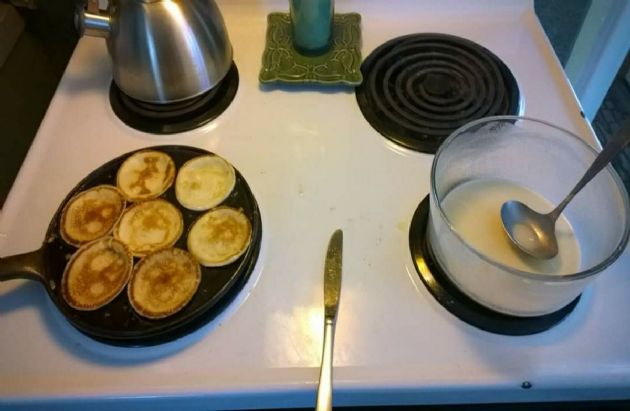Tillander Swedish Pancakes (Plattar)

Nutritional Info
- Servings Per Recipe: 9
- Amount Per Serving
- Calories: 183.1
- Total Fat: 6.7 g
- Cholesterol: 95.1 mg
- Sodium: 99.8 mg
- Total Carbs: 24.4 g
- Dietary Fiber: 0.4 g
- Protein: 6.1 g
View full nutritional breakdown of Tillander Swedish Pancakes (Plattar) calories by ingredient
Introduction
Traditional Swedish plattar or pancakes. Much more eggy than common pancakes and not fluffy at all. Delicious for any meal, but great for feeding breakfast to large, hungry families. Accompanied by bacon, coffee and orange juice, these make a festive, tasty and filling start to the day. Traditional Swedish plattar or pancakes. Much more eggy than common pancakes and not fluffy at all. Delicious for any meal, but great for feeding breakfast to large, hungry families. Accompanied by bacon, coffee and orange juice, these make a festive, tasty and filling start to the day.Number of Servings: 9
Ingredients
-
4 Eggs
2 Cups of Milk
1 Cup of Flour
1/2 Cup of Sugar
Pinch of Salt
Butter
Tips
You will need a seasoned cast iron (sometimes cast aluminum) Swedish Plett pan for this recipe. Tradition is to give the first batch to the youngest and then cycle through your crowd from youngest to oldest, each getting one pan at a time until everyone has eaten as many batches as they would like. The cook should then eat last, regardless of age. The batter can be made in advance and will keep refrigerated for about 3 days. Be sure to shake or blend thoroughly once the batter has settled. The record stands at 11 pans in one sitting...
This is Ruth (Anderson) Tillander's original recipe, as passed to my uncle, Stephen Tillander, and relayed to my brother, Brice Tillander.
Directions
In a medium size mixing bowl, combine flour, sugar, and pinch of salt, mixing thoroughly. Mix in eggs. Slowly pour in milk while stirring constantly to eliminate flour clumping. Once thoroughly blended and smooth, set aside.
Heat the plett pan to the low side of medium heat. Once heated, use a stick of butter to swipe the inside of each plattar depression. Starting in the center and moving in a consistent direction throughout the process, pour the batter mixture into each depression. (Using a small gravy ladle or a tablespoon works best.) Use enough batter to cover the bottom of the depression, but you don't need to fill the entire depth. (Doing so will make it difficult to cook thoroughly without burning one side.) Once bubbles start to stabilize on the top of each pancake, use a butter knife to flip each, following the same pattern you used to pour them. This usually takes about 2 minutes, depending on your pan, burner, and amount of batter poured. After about 45-60 seconds, use the knife to transfer the pancakes, again in the same order, to a serving plate and serve immediately.
Repeat the process, starting with the butter, until you've fed the troops. You'll want to periodically stir the batter throughout the cooking process to keep it from settling in between batches.
Great with real maple syrup and butter, even better with lingonberries, powdered sugar, and butter.
Serving Size: Makes 8-10 batches of 7 small pancakes
Heat the plett pan to the low side of medium heat. Once heated, use a stick of butter to swipe the inside of each plattar depression. Starting in the center and moving in a consistent direction throughout the process, pour the batter mixture into each depression. (Using a small gravy ladle or a tablespoon works best.) Use enough batter to cover the bottom of the depression, but you don't need to fill the entire depth. (Doing so will make it difficult to cook thoroughly without burning one side.) Once bubbles start to stabilize on the top of each pancake, use a butter knife to flip each, following the same pattern you used to pour them. This usually takes about 2 minutes, depending on your pan, burner, and amount of batter poured. After about 45-60 seconds, use the knife to transfer the pancakes, again in the same order, to a serving plate and serve immediately.
Repeat the process, starting with the butter, until you've fed the troops. You'll want to periodically stir the batter throughout the cooking process to keep it from settling in between batches.
Great with real maple syrup and butter, even better with lingonberries, powdered sugar, and butter.
Serving Size: Makes 8-10 batches of 7 small pancakes
Member Ratings For This Recipe
-
BDTILLANDER
Blaine: Uncle Stephen has been very clear: use margarine, not butter, because "butter burns". Although, I do understand this can be addressed by modifying the heat slightly. Also, they go better with sausage and orange juice than bacon and orange juice.
;-)
Brice - 12/19/19
Reply from BLAINETILLANDER (9/19/20)
Uncle Stephen is only saying that because Nana used margarine. I have to think the original family recipe predates oleo, so butter had to be the original, or maybe lard. Either way, butter tastes better and is better for you. Sausage is fine but, better than bacon? I think not.
